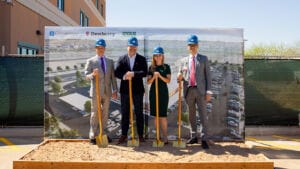Arizona’s development is expected to have a hot few years ahead of it, but no place is more on fire right now than the East Valley. General Motors announced its move to Chandler last March, with the promise of 1,000 tech-related jobs. GoDaddy broke ground in May on a Global Technology Center in Tempe. On July 30 and 31, more than $1B in economic development projects, with the Marina Heights and USA Place headquarters, were announced along Tempe Town Lake, and Grand Canyon University announced a second campus to be built in the master planned community Eastmark in Mesa, bringing thousands of jobs to the Valley. Before the end of the year, the state squeezed in another deal — Apple bought a former First Solar factory in Mesa, which will bring with it 2,000 jobs.
TEMPE
“Capital investment and the number of jobs increased substantially over (2012),” Tempe reports in its mid-year 2013 economic development budget plan for 2014, “and economic developers participated in locating companies to Tempe resulting in 12,503 jobs, with 3MSF of Class-A office space being developed and/or absorbed with a capital investment exceeding $704M.”
The city also announced two developments totaling $950M in summer. Marina Heights, a 20-acre, $600M development is the largest office development in the state and is anchored by 6- to 16-story buildings. The home of the new State Farm regional headquarters is expected to attract thousands employees. Within 24 hours, the city also announced the $350M development of USA Place headquarters, which will include a 330-room luxury hotel, a 30,000SF conference center, apartments, office and retail space as well as five full basketball courts and a 4,500-seat event center. It’s estimated this attraction will annually bring 300,000 people to Tempe.
MESA
When the recession hit Mesa, the city made cutbacks that included giving up $100,000 in capital and decreasing the economic development staff by 40 percent. The city filled a budget gap and continued to invest in the infrastructure for key projects and took advantage of lower cost construction; the Cubs spring training facility, known as Cubs Park, was contemplated at the bottom of the recession in 2009, and development of State Highway 24 has been expedited with the knowledge that the state will reimburse Mesa.
“We have a strong bond capacity because we made those cuts early on,” explains Mesa’s Director of Economic Development Bill Jabjiniak. “As we’ve come out of this, we’ve been able to handle projects people are a little surprised about.”
The city self-funded the aforementioned $84M stadium and spring training complex plus the $15M infrastructure and park leading to the stadium. The park will have a $137M impact on Arizona. Another big player is the Phoenix-Mesa Gateway Airport, which generates $1.3B in economic benefits and 10,470 jobs in or around the airport, according to a report by ASU’s W. P. Carey School of Business.
The city is now home to five “legacy” institutions, which consist of satellite campuses for established liberal arts schools, and Grand Canyon University announced its intent to build a 160-acre, second campus at the master planned community, Eastmark expected to open in 2015 with a seven-year build-out.
CHANDLER
When Motorola left a 152-acre hole in Chandler’s Price Road Corridor, the city had to decide between a “quick fix” or staying true to the space’s identity as an innovation hub equipped for technology.
“We were at a crossroads 10 years ago,” Mayor Jay Tibshraeny says. They had the option to convert the space to residential, but the mayor adds, “Our vision is not to do what’s easy but to maintain it as a job-creator and an employment center.”
That site is now Continuum — a 152-acre campus primed for business and tech with a capacity for thousands of employees.
Chandler has added 4,800 jobs since the recession. It has the largest data center in Arizona, and in August 2012, Intel invested more than $300M to build an R&D facility near its existing Chandler campus, which now employs 10,000 people. Wells Fargo broke ground in December on a 410,000 SF expansion at its downtown campus. This would nearly double the existing structure, providing an estimated 2,500 new jobs to the area. General Motors will add another 1,000 jobs to the city this year.
GILBERT
The Town of Gilbert is one of the fastest growing metros in the Valley. It has seen a consistent increase in commercial permits since 2010 and 3MSF of development since it came online the Loop 202 five years ago. The town also added 10,000 jobs in that time and $1.1B in capital among 200 companies. Gilbert has also seen significant development off U.S. Route 60, with Banner MD Anderson Cancer Center’s expansion. Gilbert also will welcome its first four-year and graduate institution in Chicago-based St. Xavier University.



